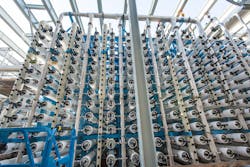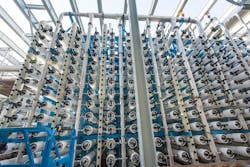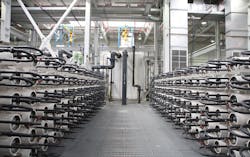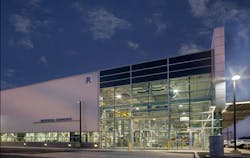International Show Preview: IDA World Congress
Now in its seventh year of severe drought, California is looking to rely more upon desalination as part of its future water supply. With the state's first mega plant in Carlsbad set to open later this year and even a former mothballed project in Santa Barbara potentially being refurbished, desalination will play a major part in Orange County's water supply.
By Randy Truby
The drought in California has gone on long enough and is severe enough that water agencies and politicians are actively involved in discussions about how to secure current and future water supplies. One of the assumptions behind these discussions is that global climate change has made long-term and more frequent droughts a reality, requiring a new approach.
Desalination has been included as a part of the future water supply matrix. Desalination of brackish well water and for wastewater reuse has been accepted. Conversely, desalination of seawater has resulted in emotional reactions, often based on misinformation or speculation about environmental disasters.
Despite the successful use of seawater desalination technology all over the world, California seems conflicted about making it part of the drought mitigation strategy.
Drought impact
California is suffering from a severe drought that is in its seventh year. The evidence is indisputable. Major water storage reservoirs are at historic low levels: Oroville at 51% of capacity and San Luis at only 47%. In a normal year, precipitation in the Northern Sierra is 48 inches.
In 2014, this was only 31 inches, and the Northern Sierra snowpack has declined from its normal 30 inches down to 1.4 inches. Lakes used for potable water supplies like Cachuma and Casitas are also at around 50% of their normal levels.
Drought, however, is not new to California. The lack of water in the southern part of the state resulted in the creation of the Los Angeles Aqueduct (LAA) in 1913 and the Colorado River Aqueduct (CRA) in 1935 and finally the State Water Project (SWP) in 1963. These successful water transfer projects have provided a reliable source of water for decades, serving agriculture in the central valley and the rapidly growing populations in the south.
Conservation has been a strategy of stakeholders for years going back to "Nip the Drip" campaigns in the 1950s. With each drought cycle, familiar campaigns to encourage water conservation were modernised and fine-tuned to re-emphasise to the public the need to use water wisely.
Environmental concerns about the impact of the SWP on the Sacramento Delta fish populations (Delta Smelt) emerged in the 1970s. Programs were proposed to keep water flowing south and also protect the Delta. The "Peripheral Canal" was one such concept promoted in the early 1980s.
Even some Northern California water districts like Santa Clara supported this canal as it would bring additional water to their customers as well. The Peripheral Canal was ultimately rejected by voters in the early 1980s. Currently, the Governor of California is discussing a tunnel concept that would again bypass the Delta.
Underground water is included in the matrix of local supply sources for water agencies that are lucky enough to have aquifers. Wells are a major source of potable water from Santa Barbara to Orange County to Oceanside. Drought not only impacts surface water like rivers, lakes and reservoirs, but the lack of precipitation also causes underground water to either decline or, in some cases, increase in salinity as seawater invades the aquifers.
Californians from north to south have repeatedly been asked to reduce their water consumption when droughts reach peak intensity -- with special emphasis on irrigation restrictions. This year, Governor Brown has required a 25% reduction and gone so far as to make statements encouraging citizens to give up their patch of green turf.
The Metropolitan Water District (MWD) has launched a program offering a $2 per square foot incentive for customers to remove turf. On the disincentive side, penalties have been increased from $500 US per citation to $10,000 US.
In summary, the drought has reduced water reserves in California, and those responsible for water supply are using a variety of means to create a sustainable solution.
Drought strategies by California Water Agencies
Water agencies across California have been planning and, in some cases, implementing drought mitigation strategies for decades. The severity of the current situation has confirmed the wisdom of their planning and added a sense of urgency.
Almost every agency has a plan that includes some form of the following:
- Reduction in the dependency on imported water from the various aqueducts (LAA, CRA, SWP)
- Conservation and customer (user) education on the need to reduce water intensive practices
- Wastewater reclamation and reuse (tertiary) for irrigation only, (purple pipe)
- Desalination of groundwater where geologically feasible
- Desalination of wastewater for either direct or indirect potable reuse.
- Desalination of seawater
- Studies to recover storm water runoff (perhaps requiring desalination).
Desalination is already in wide use, and plans call for additional installations of multi-million gallon per day systems.
Desalination of brackish water
In the 1970s when membrane desalination using the reverse osmosis process was first introduced, brackish well water was one of the obvious applications. Reverse Osmosis (RO) systems demonstrated great reliability and cost effectiveness at removing salts to meet drinking water standards.
Over the years, RO technology has become more affordable by lowering energy consumption and membrane cost. RO has also proved to be a useful technology for removing problem species like nitrates that previously rendered some aquifers unusable.
Millions of gallons of brackish well water are desalinated every day in California using RO. Installations from Oceanside to San Juan Capistrano, Corona and Irvine, Tustin and Sweetwater and others have been in operation for years. The success has been obvious. More plants are planned where the groundwater is amenable.
Unfortunately, many of the major metropolitan areas like San Diego have limited groundwater, and thus this technology will likely provide a relatively small portion of the overall water supply.
Desalination of wastewater
The Orange County Water District (OCWD) (Water Factory 21) has played a global leadership role in developing and implementing the recovery of secondary municipal effluent for potable water reuse. The Ground Water Replenishment (GWR) system in Fountain Valley recovers over 85 MGD of municipal effluent and has been expanded by another 30 MGD. The purified water is injected into the groundwater and serves as a barrier to seawater intrusion as well as for aquifer replenishment. The OCWD GWR system uses desalination technology (RO membrane) to reduce the salt content and other impurities from the municipal effluent.
The original installation in 1977 used a cellulose acetate membrane and required almost 600 psi. In the following years, polyamide thin film RO membrane has been substituted lowering the operating pressure to around 200 psi, thus saving significant energy.
Many other agencies like the West Basin Municipal Water District are already using desalination of wastewater or are planning significant installations. The City of San Diego is promoting its "Pure Water San Diego" plan and has had a demonstration desalination system running for years.
San Diego plans to install an 85 MGD system in the near future. Also in San Diego County, the Padre Dam project is in operation in the demonstration/testing phase, which will eventually be a multi-million gallon per day installation
Padre Dam is seriously evaluating Direct Potable Reuse (DPR) as their choice for how to use the purified water. The district has recognised that the purified water should be blended into the potable water supply directly and not discharged into a lake or reservoir of to be re-contaminated by untreated water.
Carbon (TOC) reduction.
The end result of this extensive treatment is pure water with a quality exceeding that of the existing drinking water supply. Permitting and regulations with the State of California must be addressed and may result in defaulting to the Indirect Potable Reuse (IPR) option.
Other municipalities are planning new desalination systems for wastewater reuse including Terminal Island in Los Angeles, and "Ventura Pure Water" where the existing tertiary treated wastewater will be processed as described above with UF followed by RO followed by UV.
Desalination of seawater
Around the world, large desalination plants are using the reverse osmosis process to desalt seawater. In Carlsbad, California a 204,412 m3/day system will go on-line in the fall of 2015. This will be the first mega plant in California.
Smaller seawater desalination plants have operated well in California for over 30 years. PG&E has a multi-million gallon per day installation at Diablo Canyon, and Chevron installed a similar plant at Gaviota. The Island of Catalina installed a drinking water desalination system at Hamilton Cove in the 1980s.
There are systems at Sand Point in Monterey County, and the City of Santa Barbara installed a seawater desalination system in the early 1990s. This system was mothballed shortly after commissioning, and parts were removed and sent to the Middle East.
Today, the City of Santa Barbara is studying what it would cost to re-furbish the desalination system as a part of their overall water supply plan.
The company that created the Carlsbad desalination system, Poseidon Resources, is also progressing on another 50 MGD plant in Huntington Beach.
Baja California is also planning a seawater desalination system near Ensenada, and there is already a large plant operating in Cabo San Lucas.
While desalination technology has been embraced for brackish well water purification and wastewater reuse, it has been met with a mixed response for seawater desalination.
The Carlsbad plant was delayed for a decade by various groups opposed to seawater desalination. Concerns over the energy required to desalinate seawater and potential harm to the ocean are most often expressed.
Water intake
In early May of this year, The California State Water Resources Control Board implemented guidelines for seawater desalination plants. In brief the Board clarified the rules as follows:
- The State has authority over desalination system intakes and discharges
- Subsurface is the preferred intake structure and must be evaluated
- Salinity limits are established for brine discharge
- Brine salinity must be monitored and reported as well as any impact on bottom dwelling organisms.
These guidelines are much more stringent than anywhere else in the world where seawater desalination is in wide use. Subsurface intakes have been used on a small scale where the location and geology permit. All but one of the mega million gallon per day desalination systems operating successfully around the world employ an open seawater intake, as will the Carlsbad system.
State guidelines will require an organisation to explore using a subsurface intake, and if it is not feasible, to seek a permit for an open intake. This will be a technical challenge and add millions (conceivably hundreds of millions) of dollars to the cost of any seawater desalination system.
Open water intakes and header/manifold brine discharge systems have successfully been used in protected locations like Perth Australia near the Great Barrier Reef.
Designs were created that protected fish from being trapped in the intake, and the Perth Water Corporation posted video of fish swimming into and out of the intake.
Studies of brine dispersal rates showed that the header/manifold design enhanced salt dispersal effectively over a short distance. These seawater desalination systems in Perth have performed so well that additional plants have been installed after Perth I in 2006. This success story has been repeated from Singapore to Australia, China and Israel as well as the Middle East.
In light of this wide and successful experience, it would appear that the new rules for California are technically and environmentally unjustified and will add huge expense to the plants. If seawater desalination plants are ever built following these rules, the rate payers will be asked to cover these extra costs in their monthly water bill.
The ultimate impact of these new seawater desalination rules will not be known until further study and comment. One would hope that modifications will improve the effectiveness of the guidelines achieving the dual benefit of protecting the environment and providing much needed water to California.
Final observations
California has successfully used desalination technology for years to add to the water supply. Large installations treating well water and for wastewater reuse are in operation, and more are planned.
Desalination of seawater has been proven and used successfully around the world. Interestingly, much of the world's desalination technology originated in California, at UCLA and General Atomic Company.
Major desalination technology manufacturers produce the membranes, pressure vessels and energy recovery devices as well as ancillary components right in California. Hopefully, Californians will not be denied the benefits of the seawater desalination technology developed and manufactured in their own communities.
Randy Truby is past president and current comptroller of the International Desalination Association, as well as President of R.L. Truby & Associates. He has served as Chairman of the Board of Directors for the Affordable Desalination Collaboration. He can be reached at [email protected]
More Water & WasteWater International Archives Issue Articles



